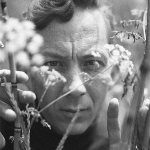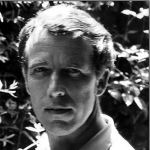Background
Wonner was born on April 24, 1920, in Tucson, Arizona, United States. He had a sister Dorothy Kendall.

1954
Paul Wonner. Photo by Rose Mandel.
1955
Young Paul Wonner.
1955
Berkeley, California, United States
Richard Diebenkorn, Paul Wonner, and William Theophilus Brown. Photograph by Lincoln Yamaguchi.
1981
San Francisco, California, United States
Paul Wonner with a cat.
2003
New York City, New York, United States
Paul Wonner and George Perle (from the book Two Men by John Jonas Gruen & Samuel Swasey).
2007
San Francisco painter Paul Wonner in his studio.
5212 Broadway, Oakland, CA 94618, USA
Wonner was a student of the California College of Arts and Crafts in Oakland (now California College of the Arts), from which he received his Bachelor of Arts degree in 1941.
215 W 57th St, New York, NY 10019, USA
Paul Wonner took classes at the Art Students League from 1947.
Berkeley, California, United States
Paul Wonner studied at the University of California, Berkeley, receiving his Bachelor of Arts in 1952, Master of Arts in 1953, and Master of Library and Information Science in 1955.








Wonner was born on April 24, 1920, in Tucson, Arizona, United States. He had a sister Dorothy Kendall.
Paul Wonner was interested in art as an adolescent and his parents hired a tutor to assist him with his drawing during secondary school. Wonner moved to the Bay Area and entered the California College of Arts and Crafts in Oakland (now California College of the Arts), from which he received his Bachelor of Arts degree in 1941, before he was drafted into military service.
After his service, Wonner moved from Texas to New York City and continued his studies. To fulfil his enthusiasm for art and painting he took classes at the Art Students League from 1947 and also attended symposiums at Robert Motherwell’s studio. There he got acquainted with various other art professionals, essayists and critics.
After returning to California in 1950, Paul Wonner studied at the University of California, Berkeley, receiving his Bachelor of Arts in 1952, Master of Arts in 1953, and Master of Library and Information Science in 1955. There he was affected by the elements of Cubism.
Early in Paul Wonner's artistic career, he used the principles of abstraction and figuration in order to create his own style. He enjoyed collegial support for his work from originators of the Bay Area Figurative Movement and later became known as one of the "Bridge Generation" artists of the movement. His works were included in the 1957 exhibition at the Oakland Museum, known as Contemporary Bay Area Figurative Painting, which gathered eleven different art specialists.
Wonner worked as a librarian at the University of California, Davis, in the late 1950s. In 1956 Paul Wonner began depicting in his artworks a progression of dreamlike male bathers and young men with bouquets. He moved to Southern California in the 1960s, where from 1962 he began teaching at the University of California, Los Angeles and in 1968 he became a lecturer at the University of California Santa, Barbara and later at the Otis College of Art and Design.
By the end of the 1960s, Paul Wonner’s style had turned from abstraction to a high realism. In 1976 he returned to the San Francisco Bay Area and kept on working as an Abstract Realist artist, creating his still life paintings. Later on, the artist went back to painting human figures in vaguely allegorical arrangements and settings.
Wonner was represented by the John Berggruen Gallery in San Francisco. The painter participated in a number of group and solo exhibitions, including those at the San Francisco Museum of Modern Art, California Palace of the Legion of Honor, Santa Barbara Museum of Art, McNay Museum, and the M.H. de Young Memorial Museum.

Paul Wonner is highly renowned for his still-life depictions done in an abstract expressionist style. His best-known paintings include the following: Still Life with Cup (1959), Figures in Sunlight (1960), Landscape with Trees, Santa Monica (1964), Model On The Floor (1964), Salome Dancing (1966), Still Life with Napkins and Gift Box (1981), etc.
Wonner’s artworks are included in different public collections around the United States, such as the Smithsonian American Art Museum in Washington, D.C., the San Francisco Museum of Modern Art, the the Oakland Museum of California, the Art Institute of Chicago, and the Soloman R. Guggenheim Museum in New York City, among others.
Repose
Still Life
Still Life with Cup
Figures in Sunlight
Landscape with Trees, Santa Monica
Model On The Floor
The Model with Pensive Look
View of L.A. from Beverly Hills
Pitcher, Lemons and Book
Salome Dancing
Yellow Bowl, Cup And Flowers
Lake, Nude, Black Hill
Untitled
Still Life with Napkins and Gift Box
Our Amazing World of Nature
Study of Flowers with Art Book
Tulips in a Milk Carton
Still Life with Bud
Self-Portrait Painting
Bathers After Cezanne II
Untitled (Nude)
Untitled (Nude)
Woman with Flowers
Man with Raised Arms
Drawing in the Studio
Landscape with Flowering Orchard
Model Bending Forward
Model Drinking Coffee
Spoons
Southwest Canyon, Arizona
View of the Sea from Malibu
Objects on Floor
The Waiter
The Tempest
Zinnias
Still Life with Indian Miniature
Untitled
Study for Still Life with Flowers in a Whiskey Bottle
Tulip
Dutch Still Life with Cookies and Candy
In a Park VII
View of Malibu #1
Quotations:
"Eventually I realized that I could connect compositional elements with shadows. People thought that was strange, because the shadows were doing things that they couldn’t do naturally."
"I began to feel as if Abstract Expressionism was talking about art, that it was always about the process. And I looked around me and I began to think that there are a lot of things in my life that I’d like to talk about in my painting. So I went outside and started painting Mt. Tamalpais, even though it still looked like Abstract Expressionism at first. The school thought I was out of my mind."
Paul Wonner was well-liked and had a charming persona.
Quotes from others about the person
Janet Bishop: "With the passing of Paul Wonner, San Francisco has lost one its finest painters and a truly lovely man."
Gretchen Berggruen: "Of all the artists I've worked with, he [Wonner] was perhaps the kindest. Just a wonderful human being. He was not about anything but the art itself."
Paul Wonner met and fell in love with his longtime companion and fellow painter, Theophilus Brown, while attending the University of California, Berkeley.

Theophilus Brown (1919-2012) was an American artist. He represented the Bay Area Figurative Movement.
